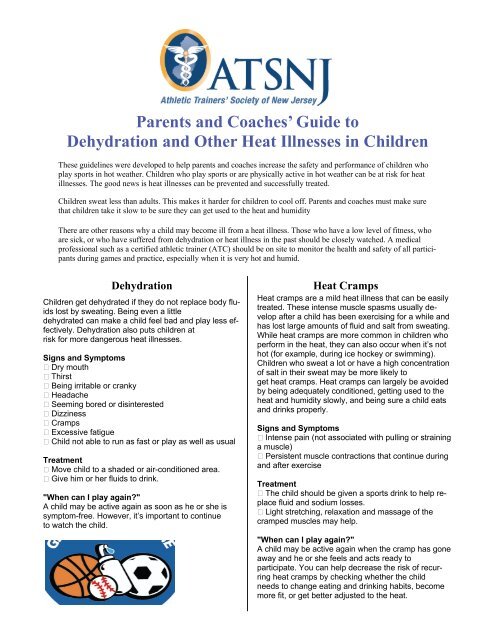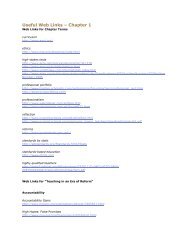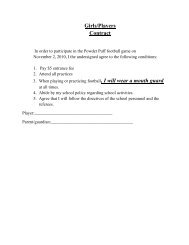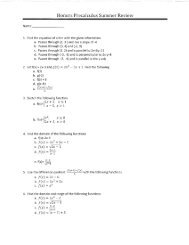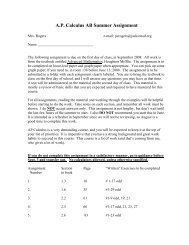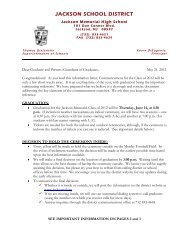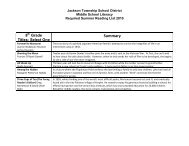Parents and Coaches' Guide to Dehydration and Other Heat ...
Parents and Coaches' Guide to Dehydration and Other Heat ...
Parents and Coaches' Guide to Dehydration and Other Heat ...
Create successful ePaper yourself
Turn your PDF publications into a flip-book with our unique Google optimized e-Paper software.
<strong>Parents</strong> <strong>and</strong> Coaches’ <strong>Guide</strong> <strong>to</strong><br />
<strong>Dehydration</strong> <strong>and</strong> <strong>Other</strong> <strong>Heat</strong> Illnesses in Children<br />
These guidelines were developed <strong>to</strong> help parents <strong>and</strong> coaches increase the safety <strong>and</strong> performance of children who<br />
play sports in hot weather. Children who play sports or are physically active in hot weather can be at risk for heat<br />
illnesses. The good news is heat illnesses can be prevented <strong>and</strong> successfully treated.<br />
Children sweat less than adults. This makes it harder for children <strong>to</strong> cool off. <strong>Parents</strong> <strong>and</strong> coaches must make sure<br />
that children take it slow <strong>to</strong> be sure they can get used <strong>to</strong> the heat <strong>and</strong> humidity<br />
There are other reasons why a child may become ill from a heat illness. Those who have a low level of fitness, who<br />
are sick, or who have suffered from dehydration or heat illness in the past should be closely watched. A medical<br />
professional such as a certified athletic trainer (ATC) should be on site <strong>to</strong> moni<strong>to</strong>r the health <strong>and</strong> safety of all participants<br />
during games <strong>and</strong> practice, especially when it is very hot <strong>and</strong> humid.<br />
<strong>Dehydration</strong><br />
Children get dehydrated if they do not replace body fluids<br />
lost by sweating. Being even a little<br />
dehydrated can make a child feel bad <strong>and</strong> play less effectively.<br />
<strong>Dehydration</strong> also puts children at<br />
risk for more dangerous heat illnesses.<br />
Signs <strong>and</strong> Symp<strong>to</strong>ms<br />
Dry mouth<br />
Thirst<br />
Being irritable or cranky<br />
Headache<br />
Seeming bored or disinterested<br />
Dizziness<br />
Cramps<br />
Excessive fatigue<br />
Child not able <strong>to</strong> run as fast or play as well as usual<br />
Treatment<br />
Move child <strong>to</strong> a shaded or air-conditioned area.<br />
Give him or her fluids <strong>to</strong> drink.<br />
"When can I play again"<br />
A child may be active again as soon as he or she is<br />
symp<strong>to</strong>m-free. However, it’s important <strong>to</strong> continue<br />
<strong>to</strong> watch the child.<br />
<strong>Heat</strong> Cramps<br />
<strong>Heat</strong> cramps are a mild heat illness that can be easily<br />
treated. These intense muscle spasms usually develop<br />
after a child has been exercising for a while <strong>and</strong><br />
has lost large amounts of fluid <strong>and</strong> salt from sweating.<br />
While heat cramps are more common in children who<br />
perform in the heat, they can also occur when it’s not<br />
hot (for example, during ice hockey or swimming).<br />
Children who sweat a lot or have a high concentration<br />
of salt in their sweat may be more likely <strong>to</strong><br />
get heat cramps. <strong>Heat</strong> cramps can largely be avoided<br />
by being adequately conditioned, getting used <strong>to</strong> the<br />
heat <strong>and</strong> humidity slowly, <strong>and</strong> being sure a child eats<br />
<strong>and</strong> drinks properly.<br />
Signs <strong>and</strong> Symp<strong>to</strong>ms<br />
Intense pain (not associated with pulling or straining<br />
a muscle)<br />
Persistent muscle contractions that continue during<br />
<strong>and</strong> after exercise<br />
Treatment<br />
The child should be given a sports drink <strong>to</strong> help replace<br />
fluid <strong>and</strong> sodium losses.<br />
Light stretching, relaxation <strong>and</strong> massage of the<br />
cramped muscles may help.<br />
"When can I play again"<br />
A child may be active again when the cramp has gone<br />
away <strong>and</strong> he or she feels <strong>and</strong> acts ready <strong>to</strong><br />
participate. You can help decrease the risk of recurring<br />
heat cramps by checking whether the child<br />
needs <strong>to</strong> change eating <strong>and</strong> drinking habits, become<br />
more fit, or get better adjusted <strong>to</strong> the heat.
<strong>Heat</strong> Exhaustion<br />
Exertional <strong>Heat</strong> Stroke<br />
<strong>Heat</strong> exhaustion is a moderate heat illness that occurs<br />
when a child continues <strong>to</strong> be physically active<br />
even after he or she starts suffering from ill effects of<br />
the heat, like dehydration. The child’s body<br />
struggles <strong>to</strong> keep up with the dem<strong>and</strong>s, leading <strong>to</strong> heat<br />
exhaustion.<br />
Signs <strong>and</strong> Symp<strong>to</strong>ms<br />
Child finds it hard or impossible <strong>to</strong> keep playing<br />
Loss of coordination, dizziness or fainting<br />
<strong>Dehydration</strong><br />
Profuse sweating or pale skin<br />
Headache, nausea, vomiting or diarrhea<br />
S<strong>to</strong>mach/intestinal cramps or persistent muscle<br />
cramps<br />
Treatment<br />
Move child <strong>to</strong> a shaded or air-conditioned area.<br />
Remove any extra clothing <strong>and</strong> equipment.<br />
Cool the child with cold water, fans or cold <strong>to</strong>wels<br />
(replace <strong>to</strong>wels frequently).<br />
Have child lie comfortably with legs raised above<br />
heart level.<br />
If the child is not nauseated or vomiting, have him or<br />
her drink chilled water or sports drink.<br />
The child’s condition should improve rapidly, but if<br />
there is little or no improvement, take the<br />
child for emergency medical treatment.<br />
"When can I play again"<br />
A child should not be allowed <strong>to</strong> return <strong>to</strong> play until all<br />
symp<strong>to</strong>ms of heat exhaustion <strong>and</strong><br />
dehydration are gone. Avoid intense practice in heat<br />
until at least the next day, <strong>and</strong> if heat<br />
exhaustion was severe, wait longer. If the child received<br />
emergency medical treatment, he or she<br />
should not be allowed <strong>to</strong> return until his or her doc<strong>to</strong>r<br />
approves <strong>and</strong> gives specific return-<strong>to</strong>-play<br />
instructions.<br />
<strong>Parents</strong> <strong>and</strong> coaches should rule out any other conditions<br />
or illnesses that may predispose the child<br />
for continued problems with heat exhaustion. Correct<br />
these problems before the child returns <strong>to</strong><br />
full participation in the heat, especially for sports with<br />
equipment.<br />
<strong>Heat</strong> stroke is a severe heat illness that occurs when a<br />
child’s body creates more heat than it can<br />
release, due <strong>to</strong> the strain of exercising in the heat. This<br />
results in a rapid increase in core body<br />
temperature, which can lead <strong>to</strong> permanent disability or<br />
even death if left untreated.<br />
Signs <strong>and</strong> Symp<strong>to</strong>ms<br />
Increase in core body temperature, usually above<br />
104°F/40°C (rectal temperature) when the<br />
child falls ill<br />
Central nervous system dysfunction, such as altered<br />
consciousness, seizures, confusion,<br />
emotional instability, irrational behavior or decreased<br />
mental acuity<br />
<strong>Other</strong> possible indica<strong>to</strong>rs include:<br />
Nausea, vomiting or diarrhea<br />
Headache, dizziness or weakness<br />
Hot <strong>and</strong> wet or dry skin<br />
Increased heart rate, decreased blood pressure or<br />
fast breathing<br />
<strong>Dehydration</strong><br />
Combativeness<br />
Treatment<br />
If there are no on-site medical personnel:<br />
Call emergency medical services for immediate<br />
transport <strong>to</strong> the nearest emergency medical<br />
facility. Begin cooling the child while waiting for<br />
<strong>and</strong> during transport <strong>to</strong> the emergency facility.<br />
If there are on-site medical personnel:<br />
Locate medical personnel immediately. Remove<br />
extra clothing or equipment. Begin aggressive<br />
whole-body cooling by immersing the child in a<br />
tub of cold water. If a tub is not available, use<br />
alternative cooling methods such as cold water,<br />
fans, ice or cold <strong>to</strong>wels (replaced frequently),<br />
placed over as much of the body as possible.<br />
Call emergency medical services for transport <strong>to</strong><br />
the nearest emergency medical facility.<br />
"When can I play again"<br />
No child who has suffered heat stroke should be<br />
allowed <strong>to</strong> return until his or her doc<strong>to</strong>r approves <strong>and</strong><br />
gives specific return-<strong>to</strong>-play instructions. <strong>Parents</strong> should<br />
work with the child’s doc<strong>to</strong>r <strong>to</strong> rule out or treat any<br />
other conditions or illnesses that may cause continued<br />
problems with heat stroke. The child should return <strong>to</strong><br />
physical activity slowly, under the supervision of an ATC<br />
or other qualified health care professional, especially for<br />
sports with equipment.<br />
This document was adapted from: Inter-Association task force on exertional heat illnesses consensus statement. June 2003. National Athletic Trainers’<br />
Association. The full document can be obtained at www.nata.org/industryresources/heatillnessconsensusstatement.pdf.


